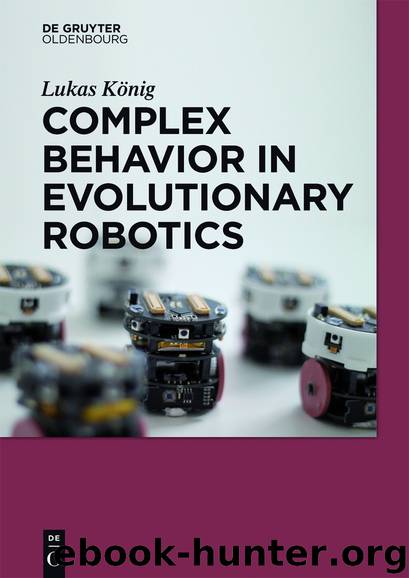Complex Behavior in Evolutionary Robotics by König Lukas

Author:König, Lukas [König, Lukas]
Language: eng
Format: epub
Publisher: De Gruyter
Published: 2015-03-08T16:00:00+00:00
Fig. 4.18. Average fitness of robots in last populations of runs with cloning reproduction. The number of parents for reproduction is depicted on the X-axis. The Y-axis reflects the average fitness values in the last populations.
Influence of the number of parents for reproduction. Fig. 4.18 and Fig. 4.19 show the average fitness of robots and the average number of successful robots in the final populations for runs with cloning reproduction (i. e., main sets of experiments 1– 4); different plot types denote the parameter usage (memory genome vs. no memory genome and CA vs. GP); the X-axis plots the number of parents for reproduction. Fig. 4.20 and Fig. 4.21 show the according data when using the recombination operator Cross instead of cloning reproduction (i. e., main sets of experiments 5 – 8).
As expected, runs with only 1 parent have not been able to achieve successful behavior in either case. Not even runs using the memory genome have reached a fitness significantly above zero despite the possibility to improve behavior by a simple random search using mutation only and storing the best genomes found by pure chance. However, as negative fitness values are treated as zero, the values for 1 parent are still slightly positive in all charts.
The performance of runs with 2 parents has been disproportionately better with the memory genome than without the memory genome (in relation to runs with 3 and more parents). This indicates that the memory genome is able to compensate for the lack of selection pressure, as observed in the preceding study, when allowing only 2 parents for reproduction. However, independently of the memory genome, both fitness and number of successful robots increase with the number of parents until an optimum is reached. The optimal number of parents seems to be between 4 and 7.
Download
This site does not store any files on its server. We only index and link to content provided by other sites. Please contact the content providers to delete copyright contents if any and email us, we'll remove relevant links or contents immediately.
Deep Learning with Python by François Chollet(14918)
The Mikado Method by Ola Ellnestam Daniel Brolund(12176)
Hello! Python by Anthony Briggs(12077)
OCA Java SE 8 Programmer I Certification Guide by Mala Gupta(11470)
Dependency Injection in .NET by Mark Seemann(11250)
A Developer's Guide to Building Resilient Cloud Applications with Azure by Hamida Rebai Trabelsi(10528)
Algorithms of the Intelligent Web by Haralambos Marmanis;Dmitry Babenko(10070)
The Well-Grounded Java Developer by Benjamin J. Evans Martijn Verburg(9708)
Grails in Action by Glen Smith Peter Ledbrook(9396)
Hit Refresh by Satya Nadella(9039)
Sass and Compass in Action by Wynn Netherland Nathan Weizenbaum Chris Eppstein Brandon Mathis(8964)
Secrets of the JavaScript Ninja by John Resig Bear Bibeault(8920)
The Kubernetes Operator Framework Book by Michael Dame(8473)
Test-Driven iOS Development with Swift 4 by Dominik Hauser(8407)
Exploring Deepfakes by Bryan Lyon and Matt Tora(8297)
Robo-Advisor with Python by Aki Ranin(8248)
Practical Computer Architecture with Python and ARM by Alan Clements(8223)
Implementing Enterprise Observability for Success by Manisha Agrawal and Karun Krishnannair(8193)
Building Low Latency Applications with C++ by Sourav Ghosh(8097)
